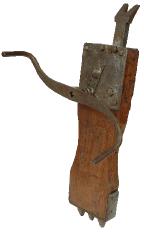Timber Jack
 The full article on this Kiwi Nugget IT’S A TIMBER JACK AND IT’S OK is published in PRODESiGN magazine, June/July 2006, p.92.
The full article on this Kiwi Nugget IT’S A TIMBER JACK AND IT’S OK is published in PRODESiGN magazine, June/July 2006, p.92.WHAT WE KNOW and WHAT WE WOULD LIKE TO KNOW:
Exploitation of New Zealand Kauri forests began in the 1820s. The principal tool for moving logs was the handspike, a lever cut from a sapling.
The timber jack is a mechanical device which transfers the rotary motion of a double-ended handle to the longitudinal extension of a steel bar or ‘spear’, which is used to stabilise or roll very heavy logs. Does a diagram of its internal workings exist?
The earliest documentation of a timber jack we have found is an 1815 John Constable painting which shows a similar appliance in the foreground. Has any earlier record been found?
Will Robinson, a saw doctor and smithy employed at Henderson Mill, “was reputedly the first man in
A Thomas Davison saw two jacks being used for loading spars on an English ship in the Hokianga in 1844-5. He bought one but because its weight, 200lb (91kg), made it unsuitable for use in the bush he had a 60lb jack made to his design by a pioneer blacksmith named Vickery. It is not clear if the company formed later, Vickery and Mansfield, produced them in volume. Davison reported that their version was superseded by an improved design made by the Price Brothers in
Will Price, son of A. & G. Price founder Alfred, understood that the firm’s first jack was made for the manager of the Kauri Timber Company in
In spite of many references to the ‘patented Price timber jack’, no record has been found. Patent 354, filed in 1879 in the name of John McLeod, Engineer of Auckland, substitutes a ‘perpetual conical cam’ for the ordinary wheels, pinions and screws used for moving the spear. The advantages he claims include a much longer thrust, prevention from recoiling under weight and increased safety and effectiveness through its reduced size and weight. There is no evidence that these improvements went into production. The patent lapsed in 1881 through non-payment of the renewal fee. There is a drawing of what can be described as a spiral cam included in teh patent. Were McLeod’s improvements ever applied to manufactured jacks?
Will Price joined A. & G. Price in 1893. By the time he retired the firm had made over 23,000 timber jacks and production was still going strong. The example in the Waipu Heritage Centre collection has the number 21421 stamped on it, which suggests they were numbered consecutively. What is the largest number known to have been stamped on a timber jack?
The Waipu museum has been told that A. & G. Price made the timber jack by hand for many years before turning to mechanised production. This may make it one of
Was this kind of timber jack produced in volume elsewhere in the world?
CAPTION:
A&G Price Timber Jack No. 21421, steel, cast iron, kauri and many coatings of oil. Waipu Heritage Centre. Photo: Peter Davies.
